 |
 |
 |
Into the Death Zone Page 2 | Back to Page 1 Climbing Higher "In one of the last lines of Conrad's novel, Heart of Darkness, Kurtz said, "The horror, the horror." We say, 'the heat, the heat.'"—David BreashearsDavid's radio calls from the mountain are full of descriptions of the climb and instant perceptions, as if he were on Everest for the first time. Although he's been here some 11 times, his child-like enthusiasm for the unique climb up Everest shines through, even in his darkest hours. I think for him, Everest is not about the moment. It is about the past, the romantic story of Everest's early climbers, like Mallory in the 20s, Tenzing and Hillary in the 50s, Hornbein in the 60s, and Habeler and Messner in the 70s. For David, being on Everest is like climbing back in time. The mountain hasn't changed a bit since the early pioneers faced what seemed like insurmountable challenges, struggling to perform in the thinnest air on Earth. The stifling, windless heat of the day in the Western Cwm hits the climbers hard and morale wanes. David radios in again and says he and the others have formed a club called "Everest Anonymous." To join, you must have been on the mountain at least twice. Pete grabs the radio from David and confesses over the radio waves, "My name is Pete and I'm an Everest offender. It all started 12 years ago...." His voice trails off, and we at Base Camp look around at each other, realizing they've gone off the deep end. The radio comes in again and we hear a group cry, "We ain't never coming back to Everest again. Never, never, never, never, never." Calls like this come in throughout the day, as the banter continues back and forth by radio until the wee hours of the evening, when we take hand-held radios with us to our tents. It's probably the best (and only) way to keep ourselves going through this stressful time. A voice interrupts the silence in my tent, and before David says goodnight from Camp II, he explains the ethos behind the formation of the club: "When any of us get this creeping thought at sea level to come back to Everest, we can call anyone in our tight network and be reminded that we took the oath: "We ain't never coming back..." Delayed at Advance Base Camp May 5—The roar of the wind heard above Camp II sent a clear signal to our climbers that it was not a good idea to move up to Camp III today. All the Sherpas who went up to the South Col (Camp IV) had to turn back due to the high winds. "We can hear the winds roaring above us like a freight train while we sit in our tent," reported David Breashears this morning. Today, the winds out of the southwest are reaching speeds on the summit of up to 75 miles per hour and the temperature could dip down as low as minus 36 degrees. When you wait one day at Advance Base Camp, there's always the fear that it could turn into many more days of waiting. We overhear David and Ed commiserating about last year, when they spent 30 days at Camp II. Everyone is hoping that this year will not see a repeat in weather patterns. "We have only enough oxygen (16 bottles) for one try," explains David while weighing the importance of this decision. "Once we decide to proceed higher, all arrows point up." May 7—There's nothing like the sound of snowfall hitting your tent. Somehow it's a soothing feeling, knowing it's freezing outside and miraculously you're warm. At 6:00 am Ed calls over to David from his tent at Camp II. "The weather forecast doesn't look good for the next few days. It looks like the winds might die down by the 11th." Two hours later David and Pete make the decision to come down. Dave Carter and his other New Zealand team members decide to come down also, to wait out the winds. Prisoners of the Khumbu Glacier 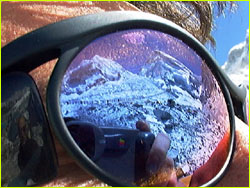 May 13—In the waiting game, you must have the discipline to keep your mind
from wandering to thoughts of home. Once you go there, it's hard to come back
to the ice and rock, the reality of the Khumbu Glacier. Simple things, like
flat ground to walk on, become deep yearnings. The thought of missing the
process of spring, the awakening of Earth, becomes a self-reproachful regret.
Another year of being deleted from the change of winter into spring feels
unthinkable. At this altitude, seasons become meaningless—it's a world of
ice, sun, snow, clouds, and solid Himalayan peaks. Change here is marked by the
movement of clouds and the monotonous slide of day into night.
May 13—In the waiting game, you must have the discipline to keep your mind
from wandering to thoughts of home. Once you go there, it's hard to come back
to the ice and rock, the reality of the Khumbu Glacier. Simple things, like
flat ground to walk on, become deep yearnings. The thought of missing the
process of spring, the awakening of Earth, becomes a self-reproachful regret.
Another year of being deleted from the change of winter into spring feels
unthinkable. At this altitude, seasons become meaningless—it's a world of
ice, sun, snow, clouds, and solid Himalayan peaks. Change here is marked by the
movement of clouds and the monotonous slide of day into night.Dave Carter philosophizes about why he has come back to climb Everest this year: "I feel like I have some unfinished business. In 1991, I don't think I 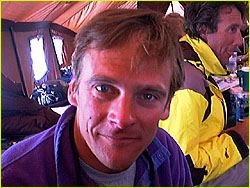 climbed the mountain right. 1991 was more of a learning year for me to climb
this mountain. This year I feel like I'm pacing myself better, I'm taking
better care of myself, I know the route and that makes a really big difference
this year. Plus, I feel like I'm acclimating better because I've been here
before. I've been to 26,000 feet and I think my body knows that. I'm not as
scared as I was in 1991. The stress makes a big difference in acclimation
also. I think those are the main reasons."
climbed the mountain right. 1991 was more of a learning year for me to climb
this mountain. This year I feel like I'm pacing myself better, I'm taking
better care of myself, I know the route and that makes a really big difference
this year. Plus, I feel like I'm acclimating better because I've been here
before. I've been to 26,000 feet and I think my body knows that. I'm not as
scared as I was in 1991. The stress makes a big difference in acclimation
also. I think those are the main reasons."Decision to Go May 17—Just when we thought we had entered the twilight zone of wait, David and Pete finally make the decision to go back up. "Tomorrow morning we leave 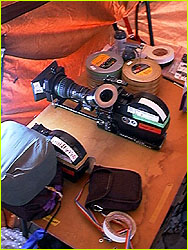 for what should be a four-day summit attempt on Mt. Everest—the South Col
Route. The main reason we're going is the obvious one, that's to make a film,
and conduct the world's highest ever neuro-behavioral tests—we hope. We need
good weather for that up high. Everything seems so easy down here and even
easier at sea level where people have great expectations and they can't even
begin to fathom the difficulty of just some of these minor tasks we have to
perform: radio interviews, neuro-behavioral tests, filmmaking."
for what should be a four-day summit attempt on Mt. Everest—the South Col
Route. The main reason we're going is the obvious one, that's to make a film,
and conduct the world's highest ever neuro-behavioral tests—we hope. We need
good weather for that up high. Everything seems so easy down here and even
easier at sea level where people have great expectations and they can't even
begin to fathom the difficulty of just some of these minor tasks we have to
perform: radio interviews, neuro-behavioral tests, filmmaking." The first week we were here (which was seven weeks ago), we named our terrace in front of our communications tent "Hypoxia Beach." It is a place where people gather in the sun to sit and soak up what will be only a few hours of warmth before the afternoon clouds and snow sets in. Today we sit facing the sun-drenched Icefall with a sense of relief. David and Pete have gone through it for what we hope will be the last time. It's almost harder to stay at Base Camp and not go up with them. I reflect on David's words from the night before: "I'll tell you right now—everybody 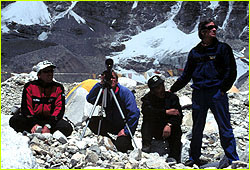 who's headed up that mountain with us—it's an amazing, astonishing, complex
human situation because you can die up there, and you can even die by not even
having a big storm, by just stepping off a cornice. And yet we're all
willingly venturing into this situation, this dangerous situation. The height
of the mountain is irrelevant, it's the amount of oxygen available. We're only
climbing 3,000 feet in a day, on the summit day, it's not a long ways in the
Rocky Mountains, it's a long way on Everest because you're marred, the higher
you go, It's not only thin air, it's a thin margin for error, and yet by virtue
of going up into that atmosphere you greatly increase you're likelihood for
making an error."
who's headed up that mountain with us—it's an amazing, astonishing, complex
human situation because you can die up there, and you can even die by not even
having a big storm, by just stepping off a cornice. And yet we're all
willingly venturing into this situation, this dangerous situation. The height
of the mountain is irrelevant, it's the amount of oxygen available. We're only
climbing 3,000 feet in a day, on the summit day, it's not a long ways in the
Rocky Mountains, it's a long way on Everest because you're marred, the higher
you go, It's not only thin air, it's a thin margin for error, and yet by virtue
of going up into that atmosphere you greatly increase you're likelihood for
making an error."David calls in from above Camp I, on their way to Camp II, and his voice breaks up in the powerful winds that are scouring the Western Cwm. "We're a half hour from Camp II and when we get there we'll be shooting some establishing shots." And the moment of regret gets swept away by the work that we all have to do. For some reason, the morning hours have a depressing air to them. Thoughts wander to the number of bodies that are lying on the route on the higher mountain. "This year as we expected, there's again the spectre of bodies on the route," reports David Breashears. "After we went up last year, Bruce Herrod died, and the reports from the Indo-Soviet ascent (this year) have him attached to the fixed rope on the Hillary Step. It doesn't appear that they took the effort to remove the body, so that task will probably fall to us, if we get up there. We thought we were through with that last year, so once was enough, but we also have requests from the families to do what we can. Especially from Andy Harris' family, who would love to know, for their own peace of mind, where Andy's body is. And last year, I think we were all too affected by the tragedy to be acting coherently up there. But looking at the slides of Rob that we took later on, only for his family's use and our analysis, there's some kind of arm or elbow of some kind protruding a few feet from him. It may be Andy or it may be Doug. But if we have the energy on the way down, we're going to dig around, if the snow's not too hard or too deep because this year Rob is completely covered. Nonetheless, on a windier year, with a year with less snow Rob will be exposed again. And Jan Reynolds, his wife, has asked if we could move his body off onto the Kangshung face side, so he won't become a slide #25 in people's slide shows in years to come. He is right on the trail, the path, the route, at a resting place on the most popular route on Everest." 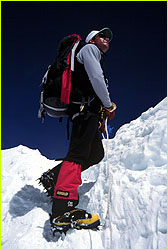 May 21—While the tension rises with each step the climbers ascend up
Everest, the bonds within our team strengthen. Of course, there are always
moments of discord, when frustrations at all that we are trying to accomplish
become heightened. But, when a voice comes through on the radio, to report on
how much water was drunk since lunch time, or when Carter says he "has to check
his schedule" if I want to interview him, we begin to miss them. What excites
us in these final moments up here is the challenge of recording live tests on
Everest. This is a real life situation and we're hopefully going to be able to
give people new insight into what contributed to the mistakes that were made
last year: how good people with good intentions with all the training in the
world can still let things go terribly wrong.
May 21—While the tension rises with each step the climbers ascend up
Everest, the bonds within our team strengthen. Of course, there are always
moments of discord, when frustrations at all that we are trying to accomplish
become heightened. But, when a voice comes through on the radio, to report on
how much water was drunk since lunch time, or when Carter says he "has to check
his schedule" if I want to interview him, we begin to miss them. What excites
us in these final moments up here is the challenge of recording live tests on
Everest. This is a real life situation and we're hopefully going to be able to
give people new insight into what contributed to the mistakes that were made
last year: how good people with good intentions with all the training in the
world can still let things go terribly wrong. The team moves up from Camp II to Camp III and Pete reports on the day's climb: "My heart was pumping the hardest it ever has." In true Walton's style, we sign off for the night, Carter and Veikka in their tent, Ed and Guy in theirs, and David and Pete in theirs: "Goodnight John Boy." "Goodnight Mary Ellen." Continue: 5:05 a.m. Lost on Everest | High Exposure | Climb | History & Culture | Earth, Wind, & Ice E-mail | Previous Expeditions | Resources | Site Map | Everest Home Editor's Picks | Previous Sites | Join Us/E-mail | TV/Web Schedule About NOVA | Teachers | Site Map | Shop | Jobs | Search | To print PBS Online | NOVA Online | WGBH © | Updated November 2000 |